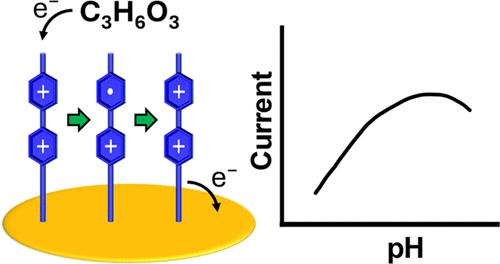Our official English website, www.x-mol.net, welcomes your
feedback! (Note: you will need to create a separate account there.)
pH Dependence of Dihydroxyacetone Oxidation by Electrocatalytic Viologen Self-Assembled Monolayers on Gold Electrodes
Langmuir ( IF 3.7 ) Pub Date : 2024-11-14 , DOI: 10.1021/acs.langmuir.4c02379 Rebekah S. Stanley, Nathan E. Pringle, David King, Seonghyeok L. Cox, Haesook Han, Pradip K. Bhowmik, Walter F. Paxton
Langmuir ( IF 3.7 ) Pub Date : 2024-11-14 , DOI: 10.1021/acs.langmuir.4c02379 Rebekah S. Stanley, Nathan E. Pringle, David King, Seonghyeok L. Cox, Haesook Han, Pradip K. Bhowmik, Walter F. Paxton

|
Carbohydrate fuel cells garner much research interest as the world’s focus shifts from fossil fuels to renewable energy. Many catalyst options are available for carbohydrate fuel cell development, including enzymes and microbes, various metal-based catalysts, and natural or synthetic mediators. Research challenges include low power output, system fouling and poisoning, inefficient electron release, and complex mechanisms, with multiple pathways leading to low product selectivity. Here, we further investigate a novel approach to catalyze carbohydrate oxidation using Au electrodes with viologen self-assembled monolayers (SAMs). SAM-mediated fuel cells have the potential to address the challenges of other catalyst systems by protecting the electrode surface and controlling the local concentration and structure to increase current generation. The effects of increasing pH on dihydroxyacetone (DHA) oxidation by three viologen SAMs on Au electrodes are presented. Current and power generated during DHA oxidation at varying pH were measured and compared to those of bare Au performance. Two of the SAMs produced more current and power than bare Au at elevated pH. The SAM system produced more current and peak power per molecule than both dilute and concentrated homogeneous viologen systems in the same cell setup. These results demonstrate the benefits and limitations of electrodes modified with redox-active groups for the production of electricity from simple sugars and other carbohydrate sources. These results are encouraging for the development of new strategies for electrical power generation from renewable resources.
中文翻译:

金电极上电催化紫精自组装单分子层对二羟基丙酮氧化的 pH 依赖性
随着世界的焦点从化石燃料转向可再生能源,碳水化合物燃料电池引起了人们的广泛研究兴趣。碳水化合物燃料电池开发有许多催化剂可供选择,包括酶和微生物、各种金属基催化剂以及天然或合成介质。研究挑战包括低功率输出、系统结垢和中毒、电子释放效率低下以及复杂的机制,多种途径导致产品选择性低。在这里,我们进一步研究了一种使用带有紫精自组装单层 (SAM) 的 Au 电极催化碳水化合物氧化的新方法。SAM 介导的燃料电池有可能通过保护电极表面并控制局部浓度和结构以增加电流产生来应对其他催化剂系统的挑战。介绍了增加 pH 值对三种紫精 SAM 对 Au 电极上二羟基丙酮 (DHA) 氧化的影响。测量了在不同 pH 值下 DHA 氧化过程中产生的电流和功率,并与裸 Au 性能的电流和功率进行了比较。在高 pH 值下,其中两个 SAM 产生的电流和功率比裸 Au 多。在相同的细胞设置中,SAM 系统比稀释和浓缩均相紫精系统产生的每分子电流和峰值功率更高。这些结果表明了用氧化还原活性基团修饰的电极在从单糖和其他碳水化合物来源发电方面的优势和局限性。这些结果为开发利用可再生资源发电的新战略提供了鼓舞人心的成果。
更新日期:2024-11-14
中文翻译:

金电极上电催化紫精自组装单分子层对二羟基丙酮氧化的 pH 依赖性
随着世界的焦点从化石燃料转向可再生能源,碳水化合物燃料电池引起了人们的广泛研究兴趣。碳水化合物燃料电池开发有许多催化剂可供选择,包括酶和微生物、各种金属基催化剂以及天然或合成介质。研究挑战包括低功率输出、系统结垢和中毒、电子释放效率低下以及复杂的机制,多种途径导致产品选择性低。在这里,我们进一步研究了一种使用带有紫精自组装单层 (SAM) 的 Au 电极催化碳水化合物氧化的新方法。SAM 介导的燃料电池有可能通过保护电极表面并控制局部浓度和结构以增加电流产生来应对其他催化剂系统的挑战。介绍了增加 pH 值对三种紫精 SAM 对 Au 电极上二羟基丙酮 (DHA) 氧化的影响。测量了在不同 pH 值下 DHA 氧化过程中产生的电流和功率,并与裸 Au 性能的电流和功率进行了比较。在高 pH 值下,其中两个 SAM 产生的电流和功率比裸 Au 多。在相同的细胞设置中,SAM 系统比稀释和浓缩均相紫精系统产生的每分子电流和峰值功率更高。这些结果表明了用氧化还原活性基团修饰的电极在从单糖和其他碳水化合物来源发电方面的优势和局限性。这些结果为开发利用可再生资源发电的新战略提供了鼓舞人心的成果。


















































 京公网安备 11010802027423号
京公网安备 11010802027423号